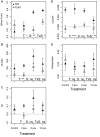Functional and Compositional Stability of Bacterial Metacommunities in Response to Salinity Changes
- PMID: 28642735
- PMCID: PMC5463035
- DOI: 10.3389/fmicb.2017.00948
Functional and Compositional Stability of Bacterial Metacommunities in Response to Salinity Changes
Abstract
Disturbances and environmental change are important factors determining the diversity, composition, and functioning of communities. However, knowledge about how natural bacterial communities are affected by such perturbations is still sparse. We performed a whole ecosystem manipulation experiment with freshwater rock pools where we applied salinity disturbances of different intensities. The aim was to test how the compositional and functional resistance and resilience of bacterial communities, alpha- and beta-diversity and the relative importance of stochastic and deterministic community assembly processes changed along a disturbance intensity gradient. We found that bacterial communities were functionally resistant to all salinity levels (3, 6, and 12 psu) and compositionally resistant to a salinity increase to 3 psu and resilient to increases of 6 and 12 psu. Increasing salinities had no effect on local richness and evenness, beta-diversity and the proportion of deterministically vs. stochastically assembled communities. Our results show a high functional and compositional stability of bacterial communities to salinity changes of different intensities both at local and regional scales, which possibly reflects long-term adaptation to environmental conditions in the study system.
Keywords: adaptation; bacteria; community assembly; community composition; community function; disturbances; resistance; salinity.
Figures



Similar articles
-
Effects of disturbance intensity and frequency on bacterial community composition and function.PLoS One. 2012;7(5):e36959. doi: 10.1371/journal.pone.0036959. Epub 2012 May 14. PLoS One. 2012. PMID: 22606316 Free PMC article.
-
The cost of adaptability: resource availability constrains functional stability under pulsed disturbances.mSphere. 2024 Feb 28;9(2):e0072723. doi: 10.1128/msphere.00727-23. Epub 2024 Jan 11. mSphere. 2024. PMID: 38206053 Free PMC article.
-
Experimental insights into the importance of ecologically dissimilar bacteria to community assembly along a salinity gradient.Environ Microbiol. 2018 Mar;20(3):1170-1184. doi: 10.1111/1462-2920.14059. Epub 2018 Feb 23. Environ Microbiol. 2018. PMID: 29393568
-
Effects of diversity and coalescence of species assemblages on ecosystem function at the margins of an environmental shift.PeerJ. 2020 Mar 9;8:e8608. doi: 10.7717/peerj.8608. eCollection 2020. PeerJ. 2020. PMID: 32195044 Free PMC article.
-
Contribution of different dispersal sources to the metabolic response of lake bacterioplankton following a salinity change.Environ Microbiol. 2017 Jan;19(1):251-260. doi: 10.1111/1462-2920.13593. Epub 2017 Jan 23. Environ Microbiol. 2017. PMID: 27871136
Cited by
-
Small-Scale Heterogeneity in Drinking Water Biofilms.Front Microbiol. 2019 Oct 29;10:2446. doi: 10.3389/fmicb.2019.02446. eCollection 2019. Front Microbiol. 2019. PMID: 31736893 Free PMC article.
-
Low shifts in salinity determined assembly processes and network stability of microeukaryotic plankton communities in a subtropical urban reservoir.Microbiome. 2021 Jun 3;9(1):128. doi: 10.1186/s40168-021-01079-w. Microbiome. 2021. PMID: 34082826 Free PMC article.
-
A Metagenomic Time-Series Approach to Assess the Ecological Stability of Microbial Mats in a Seasonally Fluctuating Environment.Microb Ecol. 2023 Nov;86(4):2252-2270. doi: 10.1007/s00248-023-02231-9. Epub 2023 Jul 2. Microb Ecol. 2023. PMID: 37393557 Free PMC article.
-
Linking Microbial Community Structure to Trait Distributions and Functions Using Salinity as an Environmental Filter.mBio. 2019 Jul 23;10(4):e01607-19. doi: 10.1128/mBio.01607-19. mBio. 2019. PMID: 31337729 Free PMC article.
-
Community-level signatures of ecological succession in natural bacterial communities.Nat Commun. 2020 May 13;11(1):2386. doi: 10.1038/s41467-020-16011-3. Nat Commun. 2020. PMID: 32404904 Free PMC article.
References
-
- Barberán A., Casamayor E. (2010). Global phylogenetic community structure and β-diversity patterns in surface bacterioplankton metacommunities. Aquat. Microb. Ecol. 59 1–10. 10.3354/ame01389 - DOI
LinkOut - more resources
Full Text Sources
Other Literature Sources

